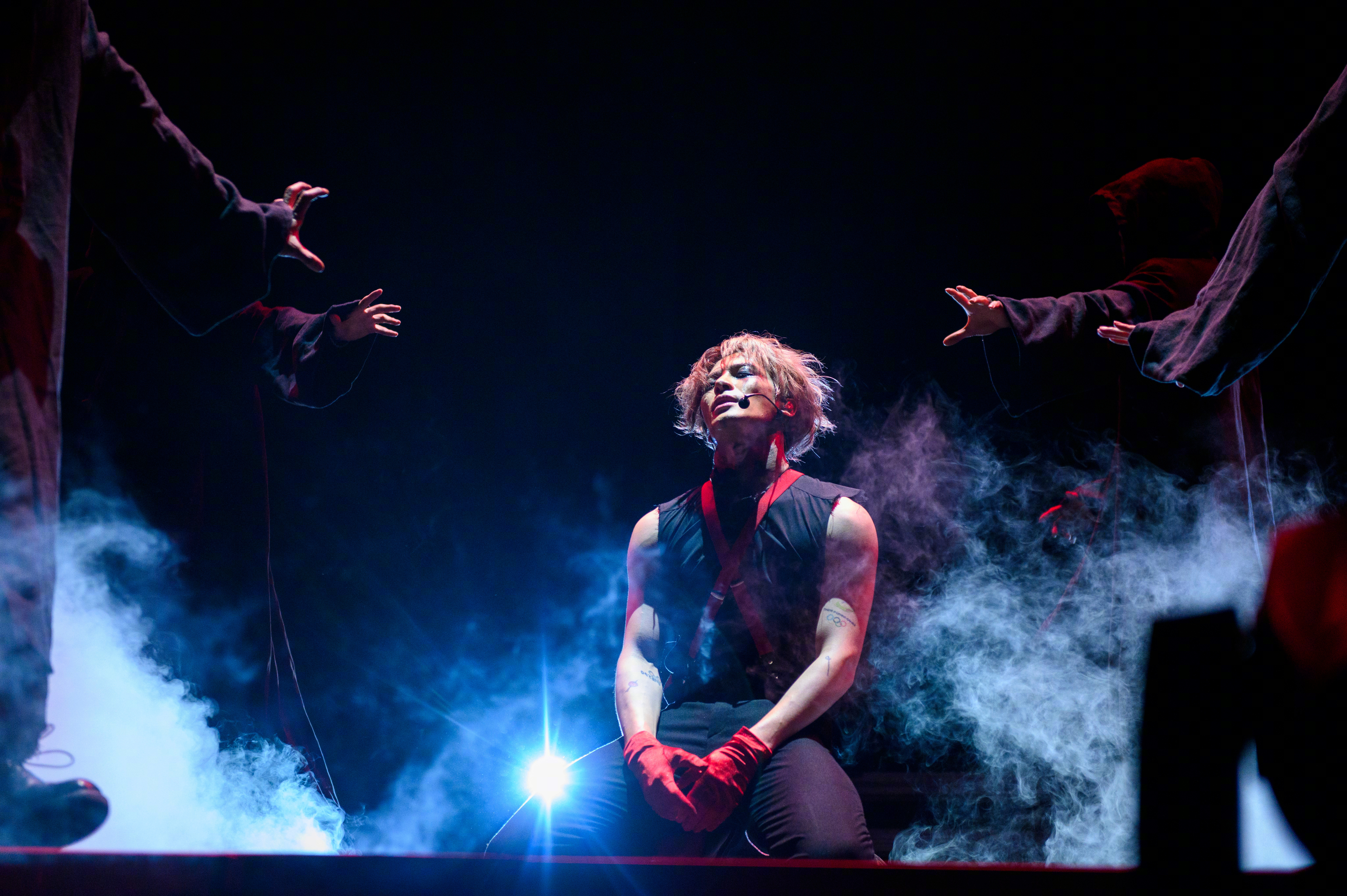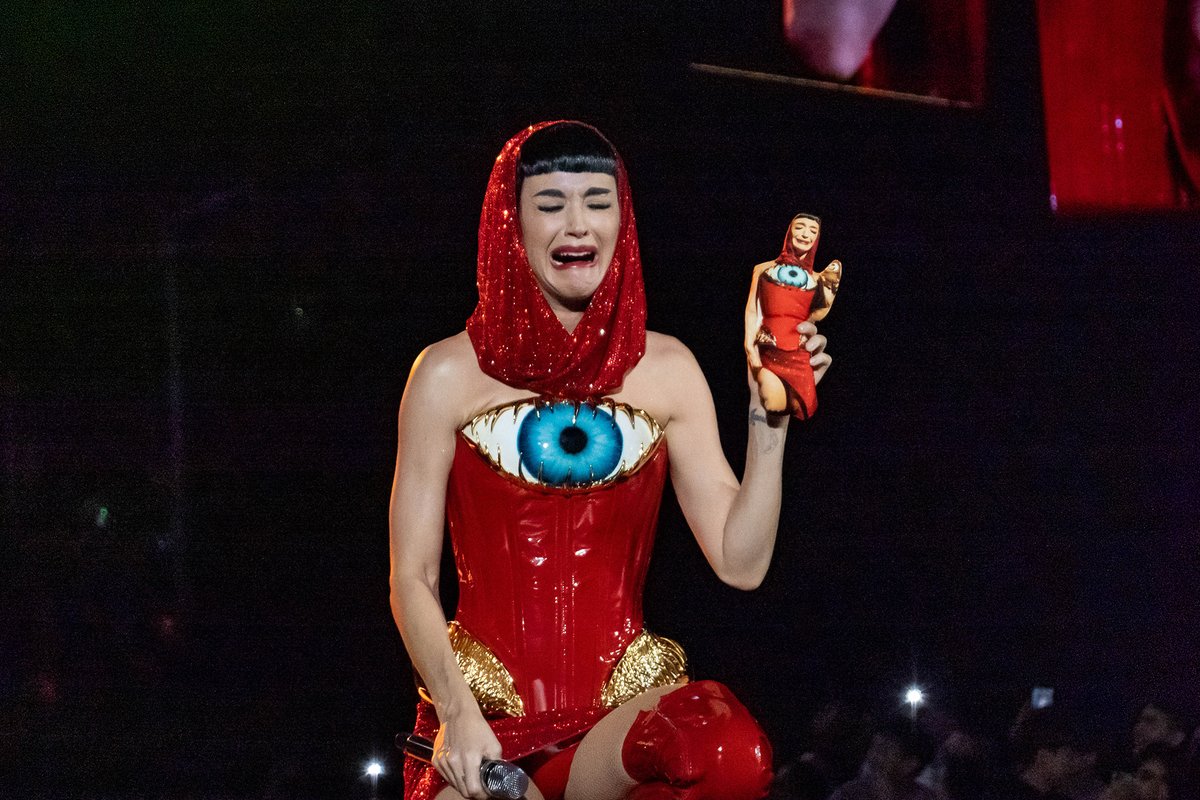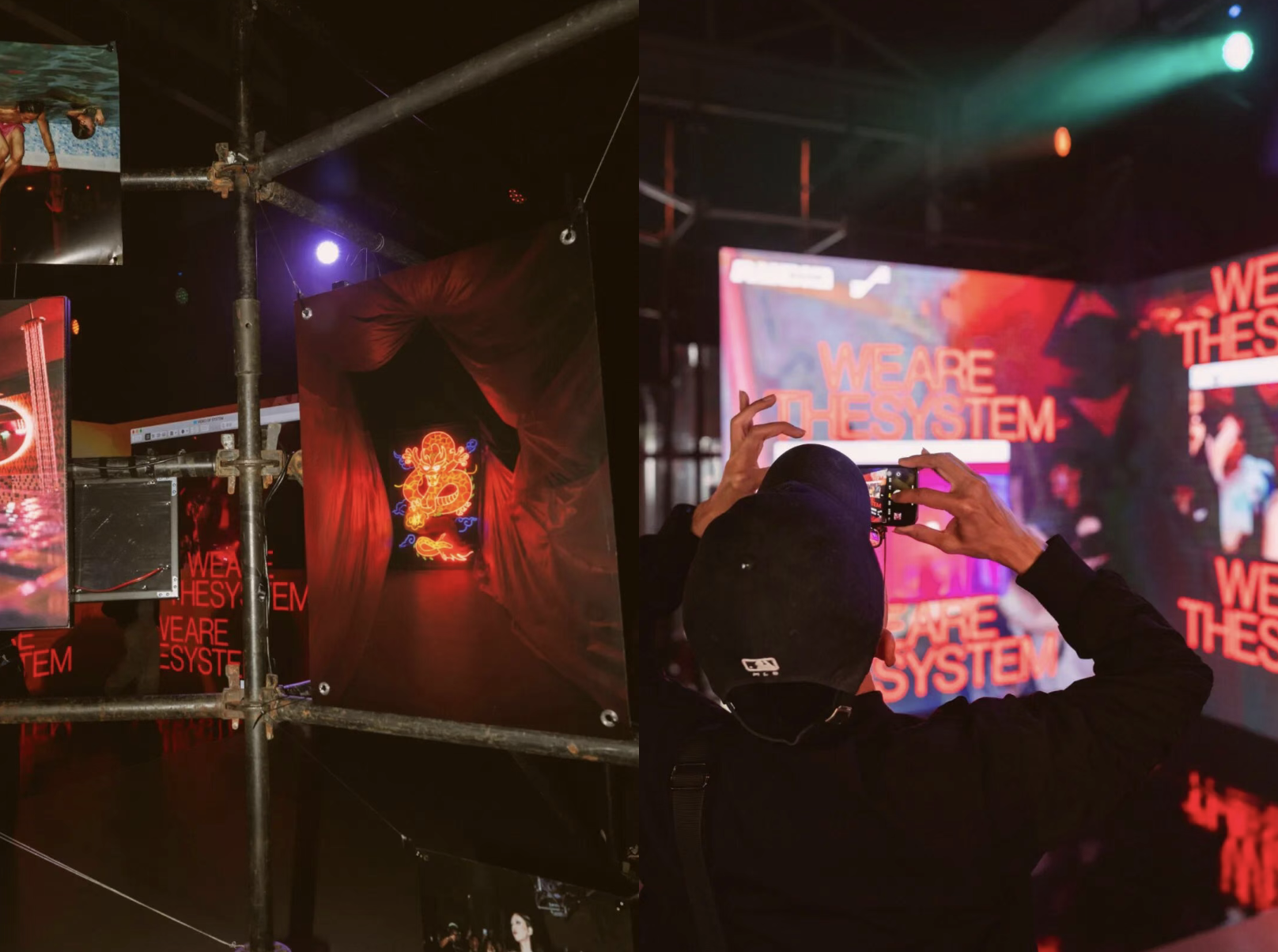Building a successful hip hop career is no easy task — just ask that kid you went to high school with. But being a successful rapper, multimedia artist, scholar, and revolutionary activist — that’s damn near impossible.
Throw a second language into the mix — make it Mandarin Chinese — and you’ve got Jamel Mims, a bilingual rapper better known by his stage name, MC Tingbudong.
A Washington, DC native, Mims has spent years exploring Chinese culture through the lens of hip hop. His art, which encompasses a spectrum of audiovisual and multimedia creations, has long been characterized by this unique cultural crossroads.
Mims’ latest endeavor is a continuation of these themes: His debut EP VIRAL, which dropped on December 3 alongside an immersive virtual world developed by himself.

A glimpse into MC Tingbudong metaverse. Screengrab via Tingbudong.nyc
It is a conversation between Black America and China, “a project about a life lived at a historic crossroads in an age of pandemic and protest.”
The virtual world includes six tracks equipped with interactive musical experiences.
The website is crafted from the perspective of a revolutionary post-racial future. It is a visual journey through the evolving esthetics of the digital era — from MS-DOS and PlayStation-esque 32-bit graphics to the wobbly, psychedelic visuals alongside the track “Thru The Window.”
The EP includes talent from across the Chinese and Asian diaspora, with producers like Eddie Lu, Harikiri, 3ASiC, Vorbi, Yohey Yamashita, DoubleClappaz, and thruoutin, and featuring artists such as Yehaiyahan and Kayla Briët.
With such a diverse range of collaborators, attaching a particular genre to the set of tracks is challenging. The “internet-driven global sound” draws inspiration from drum and bass, drill, lo-fi, trap, and j-pop, among other genres.

The musical world of Thru The Window. Screengrab via Tingbudong.nyc
At 20 minutes in length, the EP is easy to digest in a single session, but one could get lost in the virtual space for hours: It includes livestreams, games, music videos, and a host of scheduled events that can be found on the home page.
Mims, who also raps under the name Jam No Peanut, was first exposed to Mandarin as a high school student at Sidwell Friends School in DC.
As a kid, he loved anime and cartoons like Pokémon and Dragon Ball Z and was fascinated by kung fu flicks like The Last Dragon. He had also learned some Japanese in middle school, so he decided to continue his language studies in Chinese (which Japanese kanji is based on) — against the guidance of his teachers and academic counselors.
“Initially, I was really discouraged from taking Mandarin, mainly because it was considered to be such a difficult language,” Mims tells RADII.
At the time, he had just moved from a predominantly Black public school to Sidwell Friends School, a more academically rigorous private institution. Faculty advice, he says, was made “out of concern or care, but it had always been racialized … That had always shaped my initial interaction with Chinese.”

MC Tingbudong performing at China.wav LA in 2019
Nonetheless, he continued learning Chinese while pursuing a sociology degree at Boston College, eventually earning himself a scholarship with the University of Business and Economics in Beijing in 2006.
That first year in China proved a seminal experience for the young artist.
“I had always been asking this question since taking Chinese: ‘Where is the music? Where is the hip hop? Are there people who are rapping in the language?’ thinking this would be a great way to help to both learn the language and to connect with the culture,” says Mims.
It was a query that, up to this point, had fallen on deaf ears. Finally, a professor had the answer.
Mims’ photography professor connected him with Anna Sophie Loewenberg, a Beijing-based American who produced short web documentaries under the title “Sexy Beijing.”
If you’ve ever studied Mandarin, you may be familiar with Loewenberg’s quirky, self-satirizing productions, which are often shown to high school and postsecondary Mandarin students.

in his Sexy Beijing cameo. Screengrab via Youtube.
On one evening, the pair went to Yugong Yishan, an iconic venue known for its underground hip hop events, to film “Bling Bling in Beijing.” It was the night of a Section 6 event, a recurring party that brought together graffiti, skateboarding, breakdancing, and live rap, and Mims eventually found himself freestyling on stage using a combination of Mandarin and English.
His attire made the already impressive performance more interesting: a shirt reading ‘tingbudong’ (听不懂), or ‘don’t understand’ in English.
The crowd loved the ironic commentary. “His T-shirt says he can’t understand, but oh shit, he does!” Mims recalls people saying at the time. And with that, MC Tingbudong was born.
“There was a lot of interaction and engagement with that scene as a result of that video. And that was a night where a real door opened to that community,” says Mims.
His initiation into China’s hip hop community, still underground and well outside of the mainstream, couldn’t have come at a better time, as the late aughts are considered by many to be the golden age of Chinese hip hop.
MC Tingbudong grew from a spontaneously crafted stage name to a full-on creative persona in the ensuing years. This was the cultural immersion that Mims was looking for — and it wasn’t just a one-way exchange. MC Tingbudong allowed the Chinese hip hop community to see the culture through the lens of its roots in Black America.
“This is a story about this culture that began in places like New York City and the Bronx, or in the Southeast in DC where I came from,” he thought at the time. A story that “has reached this international feel and international audiences, and people all the way on the other side of the world … People from my community and from our neighborhood being able to see that would be really inspiring.”
In 2008, Mims returned to China with a Fulbright scholarship to continue what began with the Sexy Beijing video. (The Fulbright program is a US-based cultural exchange program aimed at improving cultural diplomacy and intercultural relations.)
The second time around, Mims was fully immersed in the culture. He lived with homestays, went to breakdance rehearsals and graffiti competitions, filmed videos, took notes in the bathroom after live performances, skateboarded, and, of course, did lots of partying — further developing the persona of MC Tingbudong along the way.

in conversation with RADII before China.wav LA in 2019
“It was much more participant, observation, and research driven in that kind of way,” he says.
The experiences culminated in a multimedia project called “The Misadventures of MC Tingbudong,” a combination of photography and video that dove deep into the subculture and the broader politics of the time.
Nearly a decade later, in 2018, Mims returned to China again as part of the Found Sound China program — a music diplomacy residency funded by the US State Department, which facilitates collaborations between American and Chinese producers.
This third foray into Chinese media followed the worldwide success of groups like Higher Brothers and the mainstream commercialization of hip hop through shows like The Rap of China (not to mention heightened scrutiny towards rap lyrics and rapper personas).
Needless to say, the industry was not the same as when he left, but Mims still kicked it old school.
As part of the trip, he produced an Instagram TV series on China’s underground hip hop scene and released the song “Qi Lai” along with a video shot in Southwest China’s Yunnan province. He also shared a SoundCloud mix featuring some of the artists he met on the adventure.
The utilization of various artistic mediums characterizes Mims’ latest creative pursuit, too — with a healthy dose of hyperreality thrown in. Much like the album itself, the name ‘VIRAL’ carries layers of meaning.
It was inspired by the racist implications of terms like ‘Chinese Virus’ popularized by the former US Commander-in-Chief, as well as the viral nature in which these attitudes spread — manifesting in anti-Asian violence and a proliferation of bigotry almost overnight.
“It’s also a commentary on our relationship to technology in this age of pandemic,” Mims explains.
Similarly, the Chinese-language title for VIRAL, Bu Yao Chu Men (不要出门), which translates to ‘don’t go out,’ is a nod to the early days of the coronavirus lockdown in Wuhan — a mandate perceived initially as burdensome, but one that Mims came to understand as being rooted in collective solidarity.
During this same period, Mims constructed his digital world, building the metaverse bit by bit over the past year and a half.
👾 Starting Soon! VIRAL, Live from Shanghai Community Radio. Tune In Now 👇🏾 – https://t.co/XiK0lZXhhc pic.twitter.com/zdGaXnmo8i
— MC Tingbudong aka Jam No Peanut (@JamNoPeanut) December 8, 2021
In addition to the title track, “Weixin U Were Here” (a play on the Chinese name for WeChat) is a song about connection, longing, and limitation in a world dominated by online communication. It features vocals from Kayla Briët and a range of sounds that will be familiar to users of the ubiquitous WeChat app.
Meanwhile, the closing track “Thru The Window” was initially crafted by London-based music collective Eastern Margins as a music production relay. Each of the six featured artists adds their own style to the song, resulting in an enticing melting pot of musical elements.
The pandemic era has been marked by more than just Covid-19, particularly in the United States, where grassroots activism through groups like Black Lives Matter has inspired unprecedented numbers of people in the US and worldwide to protest police violence and racial injustice.

MC Tingbudong performing at China.wav LA in 2019
Mims has been at the forefront of the modern civil rights movement for decades — from peaceful demonstrations against stop-and-frisk to present-day anti-fascist activism.
He has also been on the receiving end of racism and police brutality. In fact, it nearly cost him the opportunity that changed his life.
“My Fulbright grant to go to China — to be or become MC Tingbudong — was directly put under threat by an incident of police violence and racial oppression,” says Mims. “Boston police officers dragged my friends and me out into the street, whooped our asses, and then told us that we were disturbing the peace.”
“I think it’s taken me a while to figure out: That story was part of the process of the original iteration of the ‘Misadventures of MC Tingbudong.’”
The connection between racial justice movements in Black and Asian communities may never have been as acutely visible as it was these past two years. But these shared roots — the need for racial solidarity — have been part of Mims’ ethos for as long as he’s been spitting bilingual bars.
Indeed, they go back to the birth of the civil rights movement and the early years of the People’s Republic of China itself.
“From the Black Panthers and Mao to Huey Newton, leader of the Black Panther Party, calling on the Black Panthers to volunteer to go to Vietnam to fight against the Americans who were there. Paul Robeson and ‘Qi Lai’ in the 1930s, performing the anthem of the Chinese National Workers Party for audiences in Harlem in Chinese, W. E. B. Du Bois visiting revolutionary China — there are a lot of these connections between Black American culture during the ’60s and Chinese and Asian culture during the ’60s,” says Mims.
“Because of the unique historical circumstances of the United States being founded on slavery and genocide, the position it put … Black people and Chinese people into in particular — there’s a real shared history of actually working together to confront capitalism and imperialism and actually overthrow it,” Mims tells RADII. “It wasn’t just this vague notion of solidarity.”
VIRAL encapsulates that same energy in its post-pandemic manifestation: An intercultural anti-capitalist manifesto, a contemplation on years of pain and progress, a call to revolutionary action, and a peek Thru The Window into the mind of MC Tingbudong.
Over the first two weeks of December, Mims will host several virtual and in-person events to accompany his new EP. You can catch the next broadcast on Twitch — an interview and live performance — on December 9 at 6 PM EST via @RiseradioNYC. You can find the rest of the schedule here.
Cover image via RADII

















